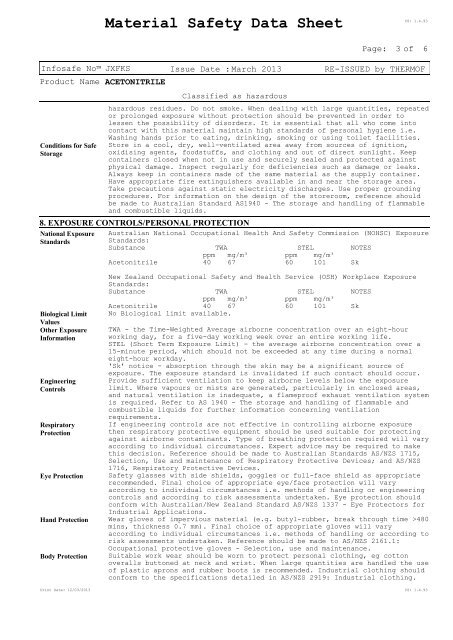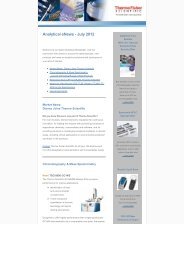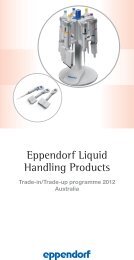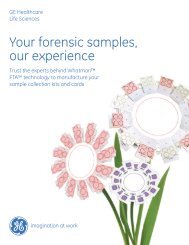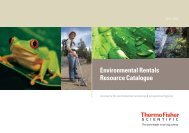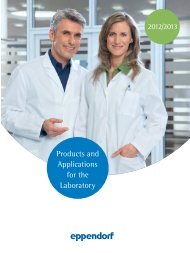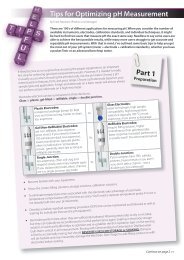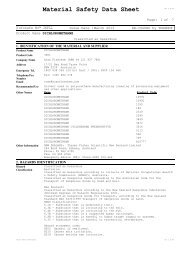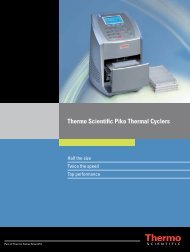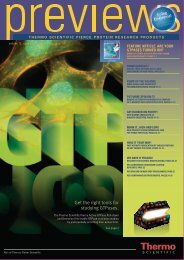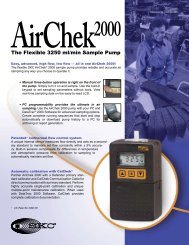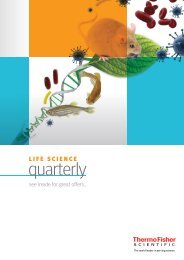View MSDS - Thermo Fisher
View MSDS - Thermo Fisher
View MSDS - Thermo Fisher
You also want an ePaper? Increase the reach of your titles
YUMPU automatically turns print PDFs into web optimized ePapers that Google loves.
Material Safety Data Sheet<br />
CS: 1.4.93<br />
Page: 3 of<br />
6<br />
Infosafe No JXFKS Issue Date : March 2013 RE-ISSUED by THERMOF<br />
Product Name ACETONITRILE<br />
Conditions for Safe<br />
Storage<br />
Classified as hazardous<br />
hazardous residues. Do not smoke. When dealing with large quantities, repeated<br />
or prolonged exposure without protection should be prevented in order to<br />
lessen the possibility of disorders. It is essential that all who come into<br />
contact with this material maintain high standards of personal hygiene i.e.<br />
Washing hands prior to eating, drinking, smoking or using toilet facilities.<br />
Store in a cool, dry, well-ventilated area away from sources of ignition,<br />
oxidising agents, foodstuffs, and clothing and out of direct sunlight. Keep<br />
containers closed when not in use and securely sealed and protected against<br />
physical damage. Inspect regularly for deficiencies such as damage or leaks.<br />
Always keep in containers made of the same material as the supply container.<br />
Have appropriate fire extinguishers available in and near the storage area.<br />
Take precautions against static electricity discharges. Use proper grounding<br />
procedures. For information on the design of the storeroom, reference should<br />
be made to Australian Standard AS1940 - The storage and handling of flammable<br />
and combustible liquids.<br />
8. EXPOSURE CONTROLS/PERSONAL PROTECTION<br />
National Exposure<br />
Standards<br />
Biological Limit<br />
Values<br />
Other Exposure<br />
Information<br />
Engineering<br />
Controls<br />
Respiratory<br />
Protection<br />
Eye Protection<br />
Australian National Occupational Health And Safety Commission (NOHSC) Exposure<br />
Standards:<br />
Substance TWA STEL NOTES<br />
ppm mg/m³ ppm mg/m³<br />
Acetonitrile 40 67 60 101 Sk<br />
New Zealand Occupational Safety and Health Service (OSH) Workplace Exposure<br />
Standards:<br />
Substance TWA STEL NOTES<br />
ppm mg/m³ ppm mg/m³<br />
Acetonitrile 40 67 60 101 Sk<br />
No Biological limit available.<br />
TWA - the Time-Weighted Average airborne concentration over an eight-hour<br />
working day, for a five-day working week over an entire working life.<br />
STEL (Short Term Exposure Limit) - the average airborne concentration over a<br />
15-minute period, which should not be exceeded at any time during a normal<br />
eight-hour workday.<br />
'Sk' notice - absorption through the skin may be a significant source of<br />
exposure. The exposure standard is invalidated if such contact should occur.<br />
Provide sufficient ventilation to keep airborne levels below the exposure<br />
limit. Where vapours or mists are generated, particularly in enclosed areas,<br />
and natural ventilation is inadequate, a flameproof exhaust ventilation system<br />
is required. Refer to AS 1940 - The storage and handling of flammable and<br />
combustible liquids for further information concerning ventilation<br />
requirements.<br />
If engineering controls are not effective in controlling airborne exposure<br />
then respiratory protective equipment should be used suitable for protecting<br />
against airborne contaminants. Type of breathing protection required will vary<br />
according to individual circumstances. Expert advice may be required to make<br />
this decision. Reference should be made to Australian Standards AS/NZS 1715,<br />
Selection, Use and maintenance of Respiratory Protective Devices; and AS/NZS<br />
1716, Respiratory Protective Devices.<br />
Safety glasses with side shields, goggles or full-face shield as appropriate<br />
recommended. Final choice of appropriate eye/face protection will vary<br />
according to individual circumstances i.e. methods of handling or engineering<br />
controls and according to risk assessments undertaken. Eye protection should<br />
conform with Australian/New Zealand Standard AS/NZS 1337 - Eye Protectors for<br />
Industrial Applications.<br />
Hand Protection Wear gloves of impervious material (e.g. butyl-rubber, break through time >480<br />
mins, thickness 0.7 mm). Final choice of appropriate gloves will vary<br />
according to individual circumstances i.e. methods of handling or according to<br />
risk assessments undertaken. Reference should be made to AS/NZS 2161.1:<br />
Occupational protective gloves - Selection, use and maintenance.<br />
Body Protection<br />
Suitable work wear should be worn to protect personal clothing, eg cotton<br />
overalls buttoned at neck and wrist. When large quantities are handled the use<br />
of plastic aprons and rubber boots is recommended. Industrial clothing should<br />
conform to the specifications detailed in AS/NZS 2919: Industrial clothing.<br />
Print Date: 12/03/2013 CS: 1.4.93


